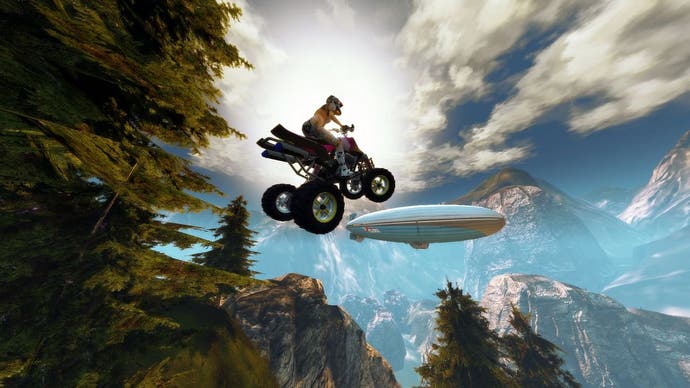Nail’d
Christ on a bike.
Ostensibly, Nail'd combines the fast-paced off-roading thrills of Black Rock's excellent Pure with the expansive environments of Codemasters' underrated FUEL, but after you've finished your first race, another game immediately springs to mind: Mario Kart Wii.
There are two reasons for this. Firstly, the handling model makes Pure look like Gran Turismo, with both MTX bike and ATV quad able to make the sharpest turns even at full speed. It's like racing as Toad with unlimited mushrooms; if you fail to make a turn it's only because you were either going so fast you didn't see it coming, or you were too busy watching your rivals disappear behind you to notice your finger was glued to the button activating your speed boost.
Secondly, like Nintendo's game, it's incredibly keen to top up your turbos. Pass through a fiery gate or a ring and your boost meter refills. Land a jump on all four wheels (or two, if you're biking it) and you get a boosty bonus. You'll more often pull off a wheelie by happy accident than design, but you'll be rewarded with yet more boost for doing so. Smashed an opponent off a cliff? More boost. Spent a few seconds not boosting? "Oh hello sir, I notice your boost meter is empty – let me refill that for you."
In short, Nail'd lets you go very, very fast very, very often. If it has another primary trait, it would probably be the amount of air that is there for the grabbing. Nail'd features the kind of vertigo-inducing leaps that in the real world would instantly hospitalise riders on landing. Yet every impact is cushioned by what must be the greatest shock absorbers in the history of videogames, these astonishing feats of digital craftsmanship somehow allowing your vehicle to carry on with barely a hint of lost speed.

Just about every race is set in the most mountainous terrain imaginable, even one which sees you whizzing through a Mediterranean village. Often the only sign that these are indeed race tracks – and not, for example, merely incredibly dangerous places for extreme-sports lunatics and their high-powered toys to zip around – are the red signs which guide competitors in the right direction.
Often, however, they'll point two different ways. Techland has managed to squeeze in a remarkable amount of choice in how you tackle each course, with myriad paths to the finish. Forks in the road do tend to end up in the same place, but for upwards of ten seconds you can often seem to be headed in the opposite direction to your opponents, only to spot them haring into view a short time later.
Of course, in some cases they've been placed there by the magic hand of the respawn. Both you and the other racers will crash, and crash often. The tracks contain enough natural hazards – rocks, trees, low-flying hot-air balloons – but Techland ups the ante, throwing you into the path of a bullet train, or sending you through a sawmill whose blades are still very much operational.
It might sound tough, but the default difficulty is not, it's fair to say, enormously challenging. The game offers an Achievement for winning a race after crashing five times which must be the easiest 10G you'll ever earn. On my first go I crossed the finishing line 26 seconds ahead of my closest rival, having crashed on 18 separate occasions. Sometimes, the AI can be astoundingly generous; after an early collision saw me drop back to 11th place, the game reset me in second.








